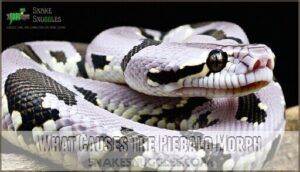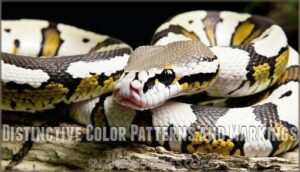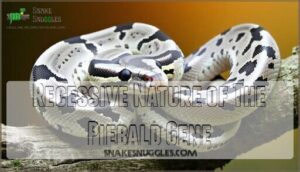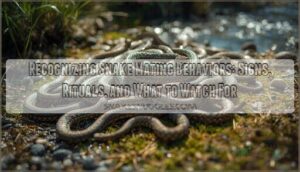This site is supported by our readers. We may earn a commission, at no cost to you, if you purchase through links.

Their docile temperament and sit-and-wait hunting strategy make them fascinating pets. However, wild populations face serious threats from habitat loss and illegal collection that removes essential breeding females. The conservation challenges reveal surprising intricacies about maintaining genetic diversity in these living works of art.
Table Of Contents
- Key Takeaways
- Unique Appearance of Pied Ball Pythons
- Fascinating Genetics and Breeding
- Noteworthy Behavior and Temperament
- Surprising Biological and Evolutionary Traits
- Conservation, Care, and Ethical Concerns
- Frequently Asked Questions (FAQs)
- What are 5 interesting facts about pythons?
- What are 3 fun facts about ball pythons?
- How long do pied ball pythons live?
- Are pied ball pythons venomous?
- Are pied ball pythons good?
- What is a pied ball python?
- Why are pied ball pythons unnatural?
- How much does a pied ball python cost?
- Are pied ball pythons nocturnal?
- Where do pied ball pythons live?
- Conclusion
Key Takeaways
- You’ll discover that pied ball pythons’ striking white patches come from a recessive gene, meaning both parents must carry it for offspring to show this rare pattern – making each snake completely unique with no two sharing identical markings.
- You can expect a docile, beginner-friendly pet that uses fascinating sit-and-wait hunting strategies, remaining motionless for days before striking prey with lightning speed using powerful constriction rather than venom.
- You’re looking at Africa’s smallest python species that carries ancient evolutionary secrets, including vestigial limb remnants and dedicated maternal behaviors where females coil around eggs for months to regulate temperature.
- You should know that wild populations face serious threats from habitat loss and illegal collection, while the exotic pet trade has exported over 2 million ball pythons since 1978, creating conservation challenges that require ethical sourcing and proper captive care.
Unique Appearance of Pied Ball Pythons
You’ll be amazed by the striking visual impact of a pied ball python’s unique coloration pattern. These exceptional snakes showcase large patches of pure white skin contrasting dramatically with their natural dark brown and black markings, creating an almost painted appearance that’s unlike any other python morph.
What Causes The Piebald Morph
You’d be surprised to learn that a single recessive gene creates the stunning piebald ball python morph. This genetic mutation disrupts pigment cells, preventing melanin production in specific areas.
When two carriers breed, there’s a 25% chance their offspring will express this color morph. The piebald ball python demonstrates how animal color morphs result from precise breeding outcomes targeting specific ball python morphs.
Distinctive Color Patterns and Markings
You’ll notice each Piebald Ball Python Morph displays unique pattern variations that make every snake special. The white patches create striking contrast against darker base colors, while markings symmetry varies dramatically between individuals. Color intensity depends on genetic influence, creating remarkable diversity within this color morph.
- Pattern Variation – No two pied ball pythons share identical white patch placement or size distribution
- White Patches – These non-pigmented areas can cover anywhere from 10% to 90% of the snake’s body surface
- Markings Symmetry – Unlike other animal color morphs, piebald patterns rarely show bilateral symmetry across the body
- Color Intensity – The pigmented areas display rich browns, blacks, and golden tones that vary between individual snakes
How Piebaldism Differs From Other Morphs
Unlike other Ball Python morphs that simply alter color intensity or shift hues, piebaldism creates dramatic pattern variation through complete scale pigmentation loss. While most color morphs redistribute existing pigments, the Piebald Ball Python displays stark white patches where melanin production stops entirely.
This recessive trait produces unpredictable markings distribution, making each Pied Ball Python unique compared to predictable morph genetics found in other ball python variations. These patterns are caused by a genetic mutation.
Fascinating Genetics and Breeding
You’ll discover that the stunning piebald pattern results from a fascinating recessive genetic trait that creates those signature white patches.
What makes these snakes truly special is how this rare mutation transforms ordinary ball pythons into living works of art worth thousands of dollars.
Recessive Nature of The Piebald Gene
Understanding the piebald gene’s recessive nature reveals fascinating insights about Ball Python genetics. You’ll need two copies of this recessive gene for the stunning piebald pattern to appear, making breeding outcomes predictable yet challenging.
Here’s what makes piebald genetics exceptional:
- Double dose required – Both parent Ball Pythons must carry the piebald gene for offspring to display the morph
- Hidden carriers exist – Normal-looking snakes can carry the recessive gene without showing piebald traits
- Genetic mutations create rarity – The piebald gene arose from natural mutations affecting gene expression patterns
- Breeding outcomes follow Mendelian ratios – Heritability estimates show a 25% chance when breeding two carriers together
This incomplete dominance pattern explains why piebald Ball Pythons command premium prices in Ball Python breeding circles.
Rarity in Wild Versus Captivity
Wild Pied Prevalence remains virtually nonexistent—you’ll find only sporadic documentation since the 1960s. Meanwhile, Captive Breeding Success has exploded from a few specimens in the 1980s to thousands today. This dramatic shift highlights Genetic Bottleneck Effects from limited wild founders and raises Ethical Sourcing Concerns about Conservation Implications for wild Ball Python populations. Piebaldism in these snakes is understood to be a simple recessive trait.
| Aspect | Wild | Captivity |
|---|---|---|
| Frequency | Extremely rare, anecdotal reports | Common, thousands bred annually |
| Documentation | Handful since 1960s | Extensive breeding records |
| Survival Rate | Low due to camouflage issues | High with proper care |
| Genetic Diversity | Unknown, limited data | Restricted by founder effect |
| Market Impact | Minimal wild collection | Major Exotic Pet Trade driver |
High Demand and Price in Pet Trade
The exotic pet trade’s enthusiasm for pied ball pythons has transformed these striking serpents into premium commodities. You’ll find that morph rarity and breeding impact directly influence market trends, with ethical sourcing becoming increasingly important for responsible pet snake ownership.
Here’s what drives piebald ball python prices in today’s pet trade:
- Pattern intensity – Higher white coverage can double standard pricing
- Breeding status – Proven females command 30-50% premiums over males
- Combined genetics – Triple morphs increase values by up to 300%
Noteworthy Behavior and Temperament
You’ll find pied ball pythons surprisingly gentle and easy-going, making them perfect pets even for beginners.
Their hunting behavior showcases fascinating predatory instincts that reveal millions of years of evolutionary adaptation.
Docile and Easygoing Nature
You’ll find that Pied Ball Python temperament makes them perfect for beginners. Their docile nature reduces bite risk markedly compared to other snake species. These gentle reptiles rarely show aggression, making handling techniques straightforward for novice owners.
When properly cared for, stress indicators remain minimal, and their calm demeanor shines through consistent pet snake behavior.
Sit-and-Wait Hunting Strategy
While their calm demeanor might suggest laziness, pied ball pythons are actually master strategists. These ambush predators rely on patience rather than speed, positioning themselves along prey trails and remaining motionless for hours or even days.
Here’s how their sit-and-wait hunting strategy works:
- Sensory Mechanisms – Heat-sensing pits detect warm-blooded prey from several feet away, even in complete darkness.
- Energy Expenditure – This method conserves massive amounts of energy compared to active hunting techniques.
- Prey Detection – Chemical receptors in their tongues identify specific scent trails left by potential meals.
- Strike Speed – When opportunity arrives, they can strike with lightning speed despite their patient reputation.
- Ambush Predation – Strategic positioning near burrows or water sources heightens hunting success rates.
Constriction as a Hunting Method
Once striking prey, Piebald Ball Pythons use their remarkable muscle strength to coil around victims, applying a crushing force that stops breathing rather than breaking bones. This constriction speed amazes researchers—these constrictors can wrap around prey in seconds.
Their evolutionary advantages as ambush predators include precise bite force coordination with their suffocating grip, making prey suffocation highly efficient. They can exert significant constriction force on prey.
Surprising Biological and Evolutionary Traits
Beyond their stunning appearance, pied ball pythons carry fascinating evolutionary secrets that showcase millions of years of adaptation.
You’ll discover remnants of their ancient past alongside impressive behaviors that reveal just how complex these seemingly simple snakes really are.
Evidence of Vestigial Limbs
Behind their docile exterior, Pied Ball Python specimens carry fascinating evolutionary remnants that tell an ancient story. These Reptile Characteristics reveal Python Regius once had legs, with modern Ball Python individuals still showing evidence through pelvic spurs near their cloaca. The python’s vestigial pelvic girdle highlights this evolutionary history.
Here’s what makes these Evolutionary Remnants so striking:
- Pelvic Spurs contain actual femur bone covered by claw-like keratin tips
- Atavistic Hindlimbs appear during Embryonic Development but degenerate before hatching
- Genetic Basis involves Sonic hedgehog gene mutations that halt limb formation early
- Males use these spurs during mating, showing they’re not completely useless
- Internal pelvic girdle structures remain hidden beneath the skin
These vestigial structures prove that even your seemingly simple Piebald Ball Python carries millions of years of evolutionary history in its DNA.
Smallest African Python Species
Python regius, commonly known as the ball python, stands out as Africa’s smallest python species within the Pythonidae family tree. While other African pythons can reach massive lengths, ball pythons max out around six feet. This dwarf python size makes them perfect for captive breeding challenges in the pet trade.
| Species | Average Length |
|---|---|
| Ball Python | 3-6 feet |
| African Rock Python | 12-20 feet |
| Southern African Python | 10-16 feet |
| Angola Python | 6-10 feet |
Despite their compact stature, pied ball python morphs face significant natural habitat threats. Their conservation status reflects pressures from deforestation and collection for the exotic pet market, where piebald ball python specimens command premium prices due to their striking appearance.
Maternal Incubation Behaviors
During the reproductive season, female ball pythons display striking maternal instincts through dedicated egg attendance. These devoted mothers practice temperature regulation by coiling around their clutch, shivering to generate heat when needed. Snake breeding enthusiasts witness this impressive nest site defense, as females rarely leave their eggs unattended. Ideal hatchling success depends on humidity and temperature. After hatching, piebald ball python mothers provide brief hatchling care before the young become independent.
Conservation, Care, and Ethical Concerns
While pied ball pythons captivate us with their stunning appearance, their story reveals serious conservation challenges that demand our attention. Understanding proper care requirements and the ethical implications of the exotic pet trade helps us appreciate these exceptional snakes while supporting their long-term survival.
Threats From Habitat Loss and Poaching
While these striking snakes showcase notable evolutionary traits, their survival faces serious challenges. Wild populations suffer dramatically from human activities that threaten their natural habitats and drive illegal collection practices.
- Deforestation Impacts: Slash-and-burn agriculture destroys underground burrows where Piebald Ball Pythons shelter and breed
- Agricultural Expansion: Mechanized farming fragments populations, isolating groups and reducing genetic diversity across West Africa
- Pesticide Effects: Chemical treatments eliminate prey species and contaminate ecosystems, disrupting the food chain
- Illegal Pet Trade: Poachers target gravid females and eggs, removing key reproductive individuals from wild populations
- Wildlife Exploitation: Bushmeat markets export python meat to Asian markets, creating unsustainable harvest pressures
Conservation efforts struggle against these mounting pressures, as habitat fragmentation makes wild Piebald Ball Pythons increasingly vulnerable to local extinction.
Proper Care Requirements in Captivity
Successfully caring for a pied ball python requires attention to essential details. You’ll need a 60-gallon tank with a proper temperature gradient ranging from 78-92°F. Maintain humidity levels between 50-60% using an appropriate substrate choice like cypress mulch.
Establish a consistent feeding schedule with appropriately-sized prey every 2-4 weeks. Pet snake ownership demands commitment to ball python care basics, including hiding spots, water bowls, and regular monitoring for peak reptile pet health.
Selecting the right tank supplies is vital for their well-being.
Impact of The Exotic Pet Trade
The exotic pet trade creates a perfect storm of problems that you should know about. Over 2 million ball pythons have been exported from West Africa since 1978, with up to 90% coming from just three countries. This massive demand drives serious issues:
- Morph Popularity fuels unsustainable wild collection targeting rare genetic variations
- Conservation Risks emerge as export quotas get exceeded due to high demand
- Ethical Sourcing becomes nearly impossible with 20% mortality during transport
- Breeding Practices suffer from genetic bottlenecks reducing diversity in captive populations
- Price Inflation reaches $8,000 for rare morphs, incentivizing questionable collection methods
The Pet Trade’s animal welfare concerns include overcrowded holding facilities and inadequate shipping conditions. It’s important to find a vet that can provide preventative snake care.
While CITES regulations exist, enforcement remains challenging across international borders, making exotic pet trade issues an ongoing conservation priority.
Frequently Asked Questions (FAQs)
What are 5 interesting facts about pythons?
Pythons are fascinating constrictors that squeeze prey to death rather than using venom. You’ll find around 40 species worldwide, with reticulated pythons being Earth’s largest snakes.
They’re ambush predators who wait patiently before striking their target.
What are 3 fun facts about ball pythons?
You’ll discover ball pythons are masters of disguise – they curl into tight balls when threatened, earning their name.
They’re incredibly patient hunters, sometimes waiting motionless for weeks before striking prey with lightning speed.
How long do pied ball pythons live?
You can expect a pied ball python to live about 20 to 30 years with proper care. That’s longer than some dogs, so owning one is a long-term commitment—think of it as a scaly roommate!
Are pied ball pythons venomous?
Relax—there’s no need to fear a bite from your pied ball python. These snakes aren’t venomous. Instead, they catch prey by constriction, giving a firm “hug,” not a toxic bite, when hunting.
Are pied ball pythons good?
Pied ball pythons make excellent pets if you’re ready for their specific needs. They’re docile, manageable in size, and stunning to look at, but they require proper heating, humidity, and can be picky eaters.
What is a pied ball python?
Unique, striking, and enchanting—you’ll find pied ball pythons are a rare color morph featuring large white patches scattered across their dark bodies, creating an eye-catching piebald pattern that’s highly sought after.
Why are pied ball pythons unnatural?
Actually, pied ball pythons aren’t unnatural – they’re a naturally occurring genetic variation that’s been selectively bred in captivity to make this beautiful white-and-brown pattern more common than you’d find in the wild.
How much does a pied ball python cost?
Funny how a snake with random white patches can cost more than a fancy dinner—expect to pay anywhere from $400 to $8,000 for a pied ball python, depending on rarity, pattern, and breeder reputation.
Are pied ball pythons nocturnal?
You’ll find these snakes snoozing during the day and coming alive at night, since they’re nocturnal. If you’re a night owl, you’ll appreciate their active hours—just don’t expect much action before sunset!
Where do pied ball pythons live?
Like hidden gems scattered across a treasure map, you’ll find pied ball pythons naturally roaming West Africa’s grasslands and savannas, from the Atlantic coast to Lake Victoria, often hiding in underground burrows.
Conclusion
Perfectly patterned pied ball pythons prove that nature’s artistry exceeds human imagination. These 11 cool facts about pied ball pythons reveal how genetics, behavior, and conservation intersect in fascinating ways. You’ve discovered that their unique white patches result from recessive genes, creating one-of-a-kind living masterpieces.
Their docile nature makes them enchanting pets, while their evolutionary traits showcase millions of years of adaptation.
However, you’ve also learned that wild populations face serious threats requiring immediate conservation action. Understanding these extraordinary serpents helps you appreciate both their beauty and the urgent need to protect their natural habitats for future generations.
- https://www.britannica.com/animal/python-snake-group
- https://www.researchgate.net/profile/Mark-Auliya/publication/354528580_Malayopython_reticulatus_The_IUCN_Red_List_of_Threatened_Species2018/links/613ceea54e1df271062e96bd/Malayopython-reticulatus-The-IUCN-Red-List-of-Threatened-Species2018.pdf
- https://journals.biologists.com/jeb/article-abstract/204/2/325/8773/Structural-Flexibility-of-the-Intestine-of-Burmese
- https://www.iucnredlist.org/search?query=Python%20regius&searchType=species
- https://kaijutegu.tumblr.com/post/134246128923/can-you-tell-us-more-of-ball-pythons-oao















